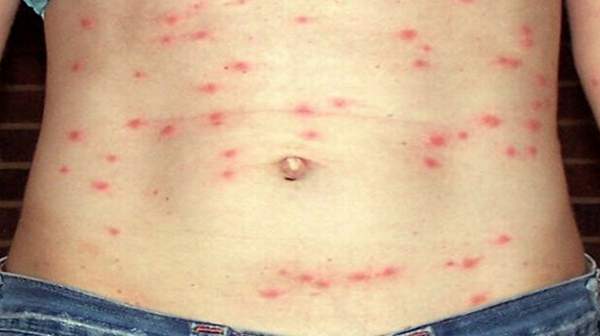Typhus Causes, Symptoms, Diagnosis and Treatment

What is Typhus?
Typhus is an acute febrile illness with more than one form. It is caused by rickettsial infection, which is endemic in many parts of the world, and is acquired via lice and fleas from other humans and small mammals such as rats, cats and squirrels (most commonly rats).
There are two major types: epidemic typhus, and endemic (or murine) typhus. Epidemic typhus is the more serious condition, which has historically been responsible for vast numbers of deaths, particularly in times of war and hardship. Today, if caught early and treated, it is not usually fatal.
Scrub typhus, technically a separate condition, is also described here due to its clinical and epidemiological similarity to typhus proper.
Causes of Typhus
Typhus is caused by 2 types of bacteria: Rickettsia typhi or Rickettsia prowazekii.
Rickettsia typhi causes endemic or murine typhus.
Endemic typhus is uncommon in the United States. It is usually seen in areas where hygiene is poor and the temperature is cold. Endemic typhus is sometimes called “jail fever.” The bacteria that causes this type is usually spread from rats to fleas to humans.
Murine typhus occurs in the southern United States, particularly California and Texas. It is often seen during the summer and fall. It is rarely deadly. You are more likely to get this type of typhus if you are around rat feces or fleas, and other animals such as cats, possums, raccoons, and skunks.
Rickettsia prowazekii causes epidemic typhus. It is spread by lice.
Brill-Zinsser disease is a mild form of epidemic typhus. It occurs when the bacteria becomes active again in a person who was previously infected. It is more common in the elderly.
Symptoms of Typhus
Symptoms of murine or endemic typhus may include:
- Abdominal pain
- Backache
- Dull red rash that begins on the middle of the body and spreads
- Fever (can be extremely high 105°F to 106°F, 40.6°C to 41.1°C) that may last up to 2 weeks
- Hacking, dry cough
- Headache
- Joint and muscle pain
- Nausea
- Vomiting
- Symptoms of epidemic typhus may include:
- Chills
- Confusion
- Cough
- Delirium
- High fever
- Joint pain
- Lights that appear very bright; light may hurt the eyes
- Low blood pressure
- Rash that begins on the chest and spreads to the rest of the body (except the palms of the hands and soles of the feet)
- Severe headache
- Severe muscle pain
- Stupor
Diagnosis of Typhus
The diagnosis is based on the patient’s clinical history, physical exam, and tests based on identification of the bacterial genus and species by PCR testing of a skin biopsy from skin rash or lesions, or blood samples. Immunohistological staining can identify the bacteria within infected tissue (skin tissue, usually).
Typhus can also be diagnosed, usually late or after the disease has been treated with antibiotics, when significant titers of anti-rickettsial antibodies are detected by immunological techniques. Although some state labs may do these tests, the CDC should be contacted for testing questions and be given information if there is an outbreak of epidemic typhus. These tests help distinguish between epidemic and endemic typhus, anthrax, and other viral diseases. The diagnosis is based on the patient’s clinical history, physical exam, and tests based on identification of the bacterial genus and species by PCR testing of a skin biopsy from skin rash or lesions, or blood samples. Immunohistological staining can identify the bacteria within infected tissue (skin tissue, usually). Typhus can also be diagnosed, usually late or after the disease has been treated with antibiotics, when significant titers of anti-rickettsial antibodies are detected by immunological techniques. Although some state labs may do these tests, the CDC should be contacted for testing questions and be given information if there is an outbreak of epidemic typhus. These tests help distinguish between epidemic and endemic typhus, anthrax, and other viral diseases.
Treatment of Typhus
Treatment includes the following antibiotics:
- Doxycycline
- Tetracycline
- Chloramphenicol (less common)
- Tetracycline taken by mouth can permanently stain teeth that are still forming. It is usually not prescribed for children until after all of their permanent teeth have grown.
- People with epidemic typhus may need oxygen and intravenous (IV) fluids.
Related Articles:
Candidiasis Causes, Symptoms, Diagnosis and Treatment
Jacquest Erythema Causes, Symptoms, Diagnosis and Treatment
Herpes Zoster Causes, Symptoms, Diagnosis and Treatment
Yaws Causes, Symptoms, Diagnosis and Treatment
Molluscum Contagiosum Causes, Symptoms, Diagnosis and Treatment
Seborrheic Dermatitis Causes, Symptoms, Diagnosis and Treatment
Monkey Pox Causes, Symptoms, Diagnosis and Treatment
Myiasis Causes, Symptoms, Diagnosis and Treatment
Osteomyelitis Causes, Symptoms, Diagnosis and Treatment
Radiation Sickness Causes, Symptoms, Diagnosis and Treatment
By : Natural Health News




